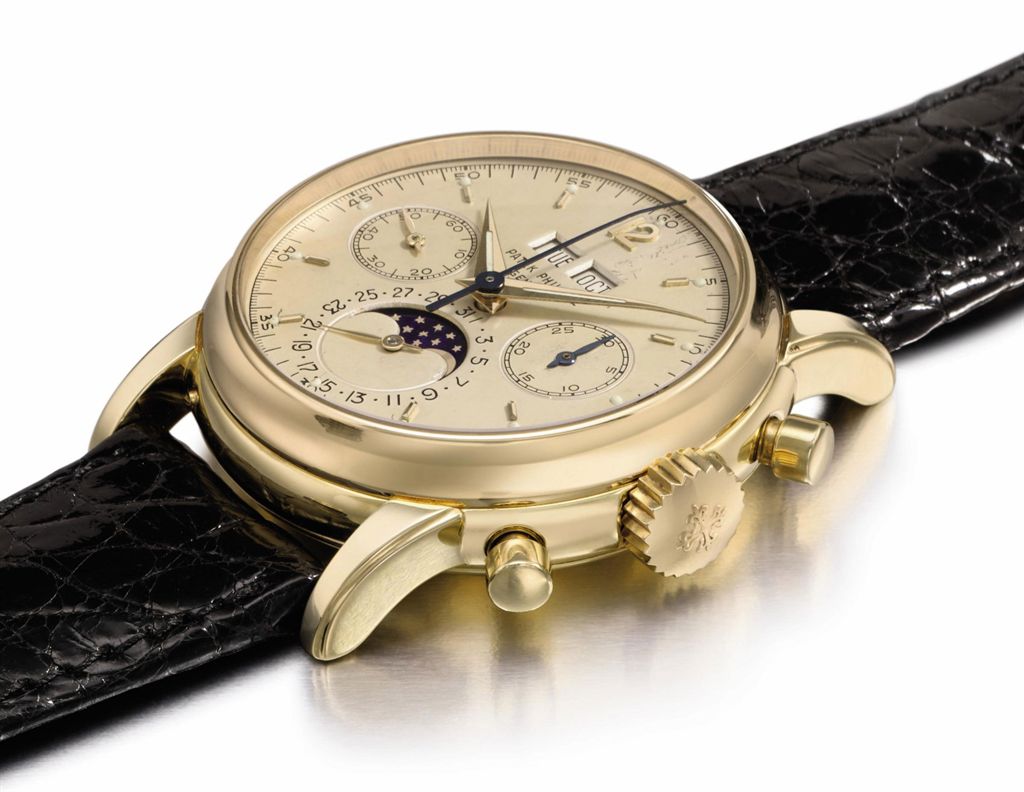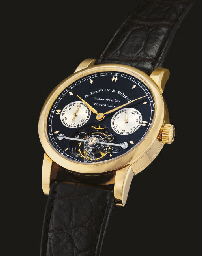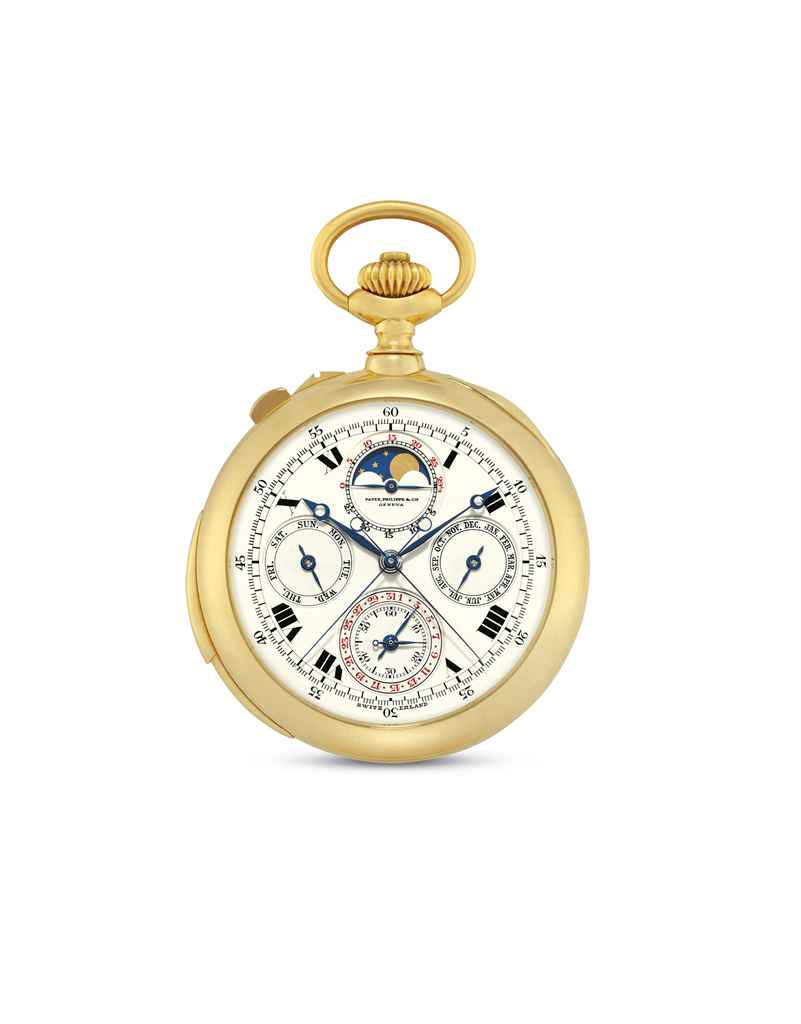A fine and rare James I or Charles I 'first period' lantern clock Initialled W.S. perhaps for William Selwood, London, circa 1625 The going train now with later anchor escapement for regulation by seconds pendulum swinging outside the frame of the clock to the rear and the strike train incorporating double-cut hoop wheel and iron countweel for sounding the hours on the bell mounted within the superstructure, the dial with unusual rose within radial sunburst engraved centre and applied narrow silvered Roman numeral chapter ring with cruciform half hour markers with a pierced iron hand and intense scroll engraved cross-hatched infill to angles, the frame with one-piece column turned corner posts and finials incorporating rounded elements at the junctions between the top and bottom plates with the lower front pair each engraved with the initials W*S and the finials flanking shaped cartouche centred foliate scroll pieced and engraved frets, the sides with hinged brass doors and the top with iron-framed bell-bearer unusually decorated with applied strips of pewter-type alloy incorporating serrated edges and secured by repeating finial rivets enclosing a bell cast with the initials WS to interior, on integral ring-decorated ball feet (formerly with verge escapement regulated by horizontal balance wheel), 39cm (15.25ins) high. Provenance: Purchased by the vendors father in Henley-on-Thames circa 1946. The current lantern clock is highly distinctive and has numerous unusual details many of which, in combination, are generally only seen on examples made during the 'first period' of English lantern clock manufacture (ie. clocks made before the Civil War). Firstly with regards to the movement, the strike train utilises a double-cut hoop wheel for locking, the countwheel is also forged from iron and is driven by a separate six-leaf pinion of report applied to the main wheel arbor (rather than being pins filed integral to the end of the arbor). The forged bell spring, check and hammer are also particularly heavy in their construction with the check being of early straight heavily-tapered form (rather than 'L'-shaped). The going train has been largely rebuilt (at the time of conversion to long pendulum regulation) to facilitate longer-duration however the original starwheel survives and is unusual being made from iron. In addition to these details it is worth noting that the pulleys are constructed with the centre and one cheek being of brass and the other cheek being of iron, and the arbors (where original) are heavily tapered with slightly stepped integral collets. When these details are considered within the descriptive list of features found on 'first period' clocks outlined in White, George English Lantern Clocks (pages 98-108) it becomes clear that the current movement originates from within this early timeframe. With regards to the frame and dial, the latter is unusual in that the upper and lower edges lap against the top and bottom plate edges (rather than the plate sitting within the space between), and is secured to the upper margin of the front movement pivot plate via a pinned iron tenon. This method of fixing again originated during the 'first period' of lantern clock manufacture (although was also a popular amongst later West Country makers). The design of the centre engraving to the dial falls into the category described in Loomes, Brian LANTERN CLOCKS & Their Makers in Chapter 2 entitled Engraved Dial Patterns - Starburst, Compass Rose, egg & Dart (pages 10-27). Indeed the 'starburst' motif seen on the current dial has its roots in Continental Renaissance work and is generally only seen on the earliest English lantern clocks. Of notable comparative interest is a clock illustrated by Loomes on page 27 (Figs. 2.43-.45) which, in addition to having related (but simpler) engraving to the dial centre, also has similar frame castings and is signed W, S. In addition to this two further clocks exhibiting the same essential compositi
A fine and rare James I or Charles I 'first period' lantern clock Initialled W.S. perhaps for William Selwood, London, circa 1625 The going train now with later anchor escapement for regulation by seconds pendulum swinging outside the frame of the clock to the rear and the strike train incorporating double-cut hoop wheel and iron countweel for sounding the hours on the bell mounted within the superstructure, the dial with unusual rose within radial sunburst engraved centre and applied narrow silvered Roman numeral chapter ring with cruciform half hour markers with a pierced iron hand and intense scroll engraved cross-hatched infill to angles, the frame with one-piece column turned corner posts and finials incorporating rounded elements at the junctions between the top and bottom plates with the lower front pair each engraved with the initials W*S and the finials flanking shaped cartouche centred foliate scroll pieced and engraved frets, the sides with hinged brass doors and the top with iron-framed bell-bearer unusually decorated with applied strips of pewter-type alloy incorporating serrated edges and secured by repeating finial rivets enclosing a bell cast with the initials WS to interior, on integral ring-decorated ball feet (formerly with verge escapement regulated by horizontal balance wheel), 39cm (15.25ins) high. Provenance: Purchased by the vendors father in Henley-on-Thames circa 1946. The current lantern clock is highly distinctive and has numerous unusual details many of which, in combination, are generally only seen on examples made during the 'first period' of English lantern clock manufacture (ie. clocks made before the Civil War). Firstly with regards to the movement, the strike train utilises a double-cut hoop wheel for locking, the countwheel is also forged from iron and is driven by a separate six-leaf pinion of report applied to the main wheel arbor (rather than being pins filed integral to the end of the arbor). The forged bell spring, check and hammer are also particularly heavy in their construction with the check being of early straight heavily-tapered form (rather than 'L'-shaped). The going train has been largely rebuilt (at the time of conversion to long pendulum regulation) to facilitate longer-duration however the original starwheel survives and is unusual being made from iron. In addition to these details it is worth noting that the pulleys are constructed with the centre and one cheek being of brass and the other cheek being of iron, and the arbors (where original) are heavily tapered with slightly stepped integral collets. When these details are considered within the descriptive list of features found on 'first period' clocks outlined in White, George English Lantern Clocks (pages 98-108) it becomes clear that the current movement originates from within this early timeframe. With regards to the frame and dial, the latter is unusual in that the upper and lower edges lap against the top and bottom plate edges (rather than the plate sitting within the space between), and is secured to the upper margin of the front movement pivot plate via a pinned iron tenon. This method of fixing again originated during the 'first period' of lantern clock manufacture (although was also a popular amongst later West Country makers). The design of the centre engraving to the dial falls into the category described in Loomes, Brian LANTERN CLOCKS & Their Makers in Chapter 2 entitled Engraved Dial Patterns - Starburst, Compass Rose, egg & Dart (pages 10-27). Indeed the 'starburst' motif seen on the current dial has its roots in Continental Renaissance work and is generally only seen on the earliest English lantern clocks. Of notable comparative interest is a clock illustrated by Loomes on page 27 (Figs. 2.43-.45) which, in addition to having related (but simpler) engraving to the dial centre, also has similar frame castings and is signed W, S. In addition to this two further clocks exhibiting the same essential compositi















Testen Sie LotSearch und seine Premium-Features 7 Tage - ohne Kosten!
Lassen Sie sich automatisch über neue Objekte in kommenden Auktionen benachrichtigen.
Suchauftrag anlegen